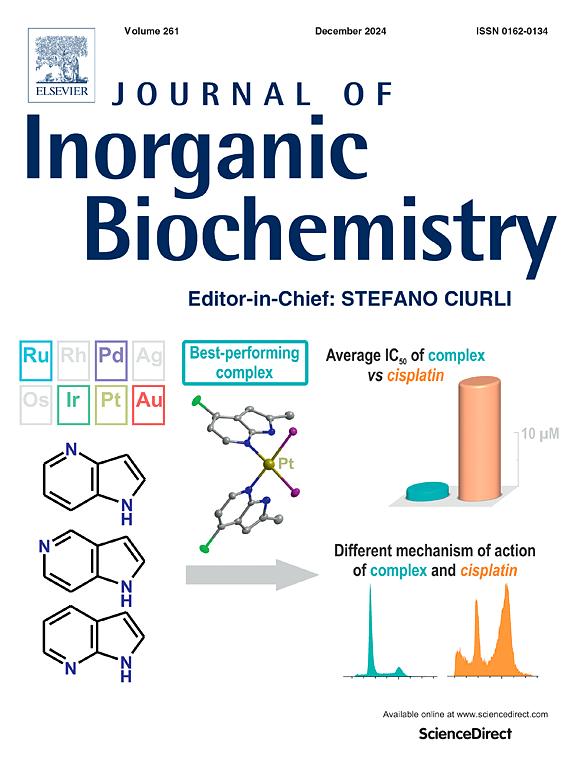Nucleus-targeted ruthenium(II) complex triggers immunogenic cell death and sensitizes melanoma to anti-PD-1 therapy by activating cGAS–STING pathway
IF 3.8
2区 化学
Q2 BIOCHEMISTRY & MOLECULAR BIOLOGY
引用次数: 0
Abstract
A significant challenge in the treatment of melanoma with immune checkpoint blockades (ICBs) is the limited T cells response often observed in immunologically “cold” tumors. By leveraging the immunogenicity of immunogenic cell death (ICD), which increases the susceptibility of tumor cells to ICBs, this study investigated the potential of a nucleus-targeted ruthenium(II) complex (Ru1) as an inducer of ICD. Treatment with Ru1 induced DNA damage in melanoma cells, activating the cyclic GMP–AMP synthase–stimulator of the interferon genes (cGAS–STING) pathway. This triggered endoplasmic reticulum (ER) stress, leading to ICD. Ru1-treated dying melanoma cells exhibited characteristics such as cell exposure of calreticulin (CRT) on the cell surface, release of adenosine triphosphate (ATP), and secretion of high-mobility group box 1 (HMGB1). Vaccination with Ru1-treated, dying melanoma cells elicited robust antitumor immune responses, as evidenced by CD8+ T cells activation, reduced Foxp3+ T cells count, and the development of a memory immune response that protected mice from subsequent melanoma challenges. Combining Ru1 with anti-PD-1 therapy significantly promoted T cells infiltration, enhanced dendritic cell activation, and reduced tumor-associated immunosuppressive factors, indicating a reprogramming of the tumor microenvironment. These findings suggest that Ru1 is a promising therapeutic agent for treating “cold” tumors in cancer chemoimmunotherapy.

核靶向钌(II)复合物通过激活cGAS-STING通路触发免疫原性细胞死亡并使黑色素瘤对抗pd -1治疗增敏
免疫检查点阻断(ICBs)治疗黑色素瘤的一个重大挑战是在免疫“冷”肿瘤中经常观察到的有限的T细胞反应。通过利用免疫原性细胞死亡(ICD)的免疫原性,增加肿瘤细胞对ICD的易感性,本研究探讨了核靶向钌(II)复合物(Ru1)作为ICD诱导剂的潜力。Ru1治疗可诱导黑色素瘤细胞DNA损伤,激活干扰素基因的环GMP-AMP合成酶刺激因子(cGAS-STING)通路。这触发内质网应激,导致ICD。ru1处理的垂死黑色素瘤细胞表现出细胞表面钙网蛋白(CRT)暴露、三磷酸腺苷(ATP)释放和高迁移率组盒1 (HMGB1)分泌等特征。接种ru1处理过的濒死黑色素瘤细胞引发了强大的抗肿瘤免疫反应,CD8+ T细胞活化,Foxp3+ T细胞计数减少,以及保护小鼠免受后续黑色素瘤攻击的记忆免疫反应的发展证明了这一点。Ru1联合抗pd -1治疗可显著促进T细胞浸润,增强树突状细胞活化,降低肿瘤相关免疫抑制因子,提示肿瘤微环境重编程。这些发现提示Ru1在癌症化学免疫治疗中是一种很有前景的治疗“冷”肿瘤的药物。
本文章由计算机程序翻译,如有差异,请以英文原文为准。
求助全文
约1分钟内获得全文
求助全文
来源期刊

Journal of Inorganic Biochemistry
生物-生化与分子生物学
CiteScore
7.00
自引率
10.30%
发文量
336
审稿时长
41 days
期刊介绍:
The Journal of Inorganic Biochemistry is an established international forum for research in all aspects of Biological Inorganic Chemistry. Original papers of a high scientific level are published in the form of Articles (full length papers), Short Communications, Focused Reviews and Bioinorganic Methods. Topics include: the chemistry, structure and function of metalloenzymes; the interaction of inorganic ions and molecules with proteins and nucleic acids; the synthesis and properties of coordination complexes of biological interest including both structural and functional model systems; the function of metal- containing systems in the regulation of gene expression; the role of metals in medicine; the application of spectroscopic methods to determine the structure of metallobiomolecules; the preparation and characterization of metal-based biomaterials; and related systems. The emphasis of the Journal is on the structure and mechanism of action of metallobiomolecules.
 求助内容:
求助内容: 应助结果提醒方式:
应助结果提醒方式:


